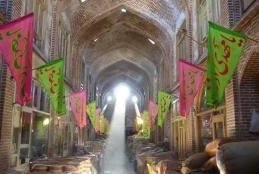
A few comments additional to Els’s thorough review
a. We visited first in the late afternoon and then again briefly the next morning to catch up on some areas which had been closed. It was a surprise to us to discover that, rather contrary to “popular belief” regarding a country which “stays up late”, a lot of the bazaar closes for the day around 4-5pm. Many areas of the bazaar are primarily wholesale (or even manufacturing) locations and their “business” is done early, unlike that of the tourist and gold etc areas! This early closure particularly impacts the Carpet Bazaar (The Mozaffarieh Timcha) if you want to see that (it is quite nice to watch the “carpet finishers” working on the floor of this area). You may not even know that such areas exist as they close off access from the main Bazaar by shutting their enormous mediaeval doors and you would have no idea of what lies behind.
b. To “add value” to the visit experience it is worth trying to understand and chase down the different social and architectural elements of the Bazaar as described in the AB evaluation and (more fully) in the Nomination file (Sarays, Timchas, Rastas, Charsugs, Dalans and Bazarchas!). Their names are usually marked by brass plates within the bazaar. The essence of Tabriz Bazaar’s case for OUV lies in this range of architectural and social spaces.
c. Maps of the main covered bazaar are as rare as hens’ teeth. Our guide managed to get one from the nearby “Constitution House” museum. I provide this link to a photo of it as it shows all the different architectural elements rather nicely in different colours.
d. Like Els, I find the official inclusion of the Blue Mosque within the “Bazaar” very strange – particularly as it still remains on Iran’s T List and also that, within the confines of the Mosque itself, there is absolutely NO indication that it has been inscribed! The area behind the mosque (i.e facing its historic main entrance) which is shown on Nomination File maps as leading to the bazaar actually seems to have no physical link to it and indeed seemed to be a large building site. I wonder if Iran felt it needed to include it to beef up the OUV or, alternatively whether it was “slipping in” a building which might not justify nomination on its own? ICOMOS comments merely that “the15th C Gol Machid merits inclusion…by virtue of its relation to the Karaney-khana, Rahli and Kohna Bazarchasi and its importance as a monument in its own right”. The argument for including these additional bazaar areas seems to be that the main bazaar area we see today has been unnaturally curtailed by the modern dual carriageways of Jomhuriye Eslami and Shahad Motahhari Streets (see map). Well, possibly, but the argument seems a bit “thin” to me, especially the comment that it justifies inclusion as “a monument in its own right” – maybe, but then it shouldn’t utilise the Bazaar’s OUV!
e. I wouldn’t like to attempt comparisons with other bazaars on the List, despite having visited Aleppo and Damascus in happier times, together with many other examples across the Middle East. It is perhaps true that Iran did well to identify a particular “differentiating point” for the nomination in the form of the Bazaar’s “socio-architectural” significance. We are not great “shoppers” whilst travelling and gain no particular pleasure from perusing their souvenir stalls, so “Bazaars” for us usually only provide a quick opportunity to gain a bit of local colour and look at piles of spices, “foreign” fruits etc! The additional interest gained from looking at the Bazaar from a different viewpoint did “add value” for us. How unique these aspects really are is another matter – by looking for them we certainly saw them later in the trip e.g at Isfahan. However, as the Nomination indicates, Isfahan did post-date Tabriz.
More on
Comments
No comments yet.
